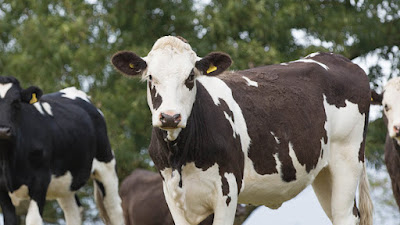Leptospirosis | Cause | Symptoms | Prevention | Treatment
Cause
Leptospirosis is a zoonotic disease, caused by bacteria of genus Leptospira. Depending on location different serogroups are often more prevalent.
Some examples of different serovars include hardjo, pomona, canicola, icterohaemorrhagiae, and grippotyphosa.
Cattle are the maintenance hosts for hardjo, but as this is specialised to survive within cattle, the infection is less severe. Animals infected with other strains (such as pomona) suffer more severe illness.
Maintenance hosts carry the bacteria and expose other susceptible animals. Maintenance hosts can be cattle, pigs, dogs, rodents or horses.
An animal may be infected by serovars maintained by its own species (maintenance host infection or host-adapted infection) or serovars maintained by other species (incidental infection or non host-adapted infection).
Leptospirosis is transmitted either directly between animals or indirectly through the environment.
 |
| A brief overview of Leptospirosis in Cows |
Symptoms
The clinical signs of Lepto depend on the herd’s degree of resistance or immunity, the infecting serovar, and the age of the animal infected.
Host-adapted
Leptospira hardjo-bovis is the only host-adapted Lepto serovar in cattle and can infect animals at any age, including young calves. Because cattle are the maintenance host for hardjo-bovis, infection with this serovar will often produce a carrier state in the kidneys associated with long-term urinary shedding.
In addition, infections with hardjo-bovis can persist in the reproductive tract. The infertility that can result from persistent reproductive tract infections is perhaps the most economically damaging aspect of leptospirosis. Low antibody titers are typically associated with hardjo-bovis infections, making detection and diagnosis difficult.
Nonhost-adapted
Lepto serovars include Leptospira pomona, icterohaemorrhagiae, canicola, and grippotyphosa. Because cattle are incidental hosts for these Lepto serovars, the clinical signs are typically very different than infection with hardjo-bovis.
When leptospirosis associated with nonhost-adapted Lepto serovars occurs in calves, the result is high fever, anemia, red urine, jaundice, and sometimes death in three to five days.
In older cattle, the initial symptoms such as fever and lethargy are often milder and usually go unnoticed. In addition, older animals usually do not die from leptospirosis. Lactating cows produce less milk, and, for a week or more, the milk they produce is thick and yellow.
Leptospirosis with nonhost-adapted Lepto serovars also affects pregnant cows causing embryonic death, abortions, stillbirths, retained placenta, and the birth of weak calves. Abortions usually occur three to ten weeks after infection.
Treatment
Antibiotic therapy should be prescribed for animals with leptospirosis. Antibiotics can also eliminate persistent infections.
Infected animals should be segregated from others to avoid transmission of the disease.
Treatment has proven most effective when animals are treated during the leptospiremia. However, antibiotic therapy during chronic infection may reduce the carrier status.
When infection storms through a herd, especially when many pregnant cows are involved, simultaneous treatment and vaccination of all animals will reduce new cases and abortions if treatment is administered early in the herd infection.
Prevention
Vaccination is relied on to increase resistance to infection.
The primary course of immunization consists of two injections four weeks apart followed by annual boosting. Vaccination should prevent urine shedding following exposure and will protect against milk drop and abortion.
Annual vaccination should be used in closed herds, whereas semiannual vaccination should be considered for open herds.
Calves born from vaccinated cows are only immune for about six months, and will need their own programme of vaccination.
Management methods to reduce transmission include rat control, fencing cattle from potentially contaminated streams and ponds, separating cattle from pigs and wildlife, selecting replacement stock from herds that are seronegative for leptospirosis, and chemoprophylaxis and vaccination of replacement stock.
In some cases streptomycin is added as a precautionary measure to semen from bulls held at artificial insemination centers.
